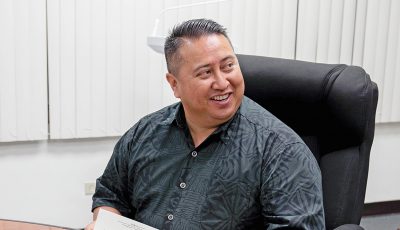The story of PUA
Since joining the team at the Department of Labor, one of the most common inquiries I get has been about the PUA program. I have spent the majority of my time in these first weeks learning about PUA and all the changes that have occurred since its inception. The way I see it, the story of PUA begins as one of emergency and urgency. It was as if the great flood began before Noah had finished building the ark, except that the CNMI was building the ship while we were already on the water. There were many holes in the ship taking on water, but we had to keep it afloat at all costs. In that process, there were a lot of growing pains that both the community and the agency had to bear.
To start, I want to acknowledge the frustrations shared across the public discourse, from backyard conversations to Facebook group outreach: Yes, there were problems with the call center being busy, unhelpful and sometimes incorrect. Yes, there were documents lost, sometimes multiple times, there was portal confusion and portal mistakes. Yes, employees needed more training, more empathy and more support to be able to meet the urgent needs of the CNMI residents who are entitled to this benefit. Yes, you deserve to be heard. We have been listening. You have been heard.
We at the Department of Labor want to help build some understanding on all sides of the story so the community can see the immense efforts that have been made toward improving the process and service to the people who have been waiting so long.
What I have found in the short time I have been with the department is that it is very clear that the gathering and submission of supporting documents represents the greatest hurdle for claimants and adjudicators in finalizing PUA claims.
The adjudication process sometimes takes weeks or even months to complete. The fastest adjudications happen for claimants with complete documents, who were U.S. citizens, furloughed/terminated, and non-business owners. In reality, most cases are not so simple and clear cut. Most PUA cases are more complicated depending on the PUA claimant’s individual status as an employee or employer; visa holder or a U.S. worker; whether or not they had reduced hours, were furloughed or experienced a layoff. The sheer fact that there is a lack of standardization of documentation in the private sector is a huge hurdle for adjudicators. Think of all the different ways employers monitor time—very few timesheets/cards are the same, adjudicators must learn to decode each type of timesheet to include in a claim. This takes time and training.
The lack of documents and the loss of documents is also a huge issue, especially for businesses and employers who have closed down since the pandemic began. Not to mention, we have to factor in the personal obligations that can happen, such as child support arrears and judgments from court. All of this documentation is a huge barrier to each claimant waiting for PUA. The fact is also clear that every individual case for PUA is unique based on each of those factors. All of those factors contribute to the length of time it takes to adjudicate a claim.
Another barrier that contributes to the documentation issues are that the rules guiding PUA have changed multiple times, and in each change, we must apply those rules to all open pending cases. (Closed cases are closed, BUT if you reopen them, you must apply all the new rules and that can also be frustrating because this can result in an overpayment due to changes in the rules, so to anyone considering this, be careful if you are reopening your closed case.) Modifications in the rules can mean new documents are required that were not required in the last rule change. This can be frustrating to someone who called last month and now is being asked for additional documents. It is important to know, the rules for PUA have been modified over 20 times since it began in 2020. For example, if you currently have an open case, you got a new email notification because of a finding from the grantor regarding a rule change. This change requires the team to review all pending cases (1,000+) and apply the rule to all open cases. Rule changes change the timelines of the work adjudicators are doing every time.
Another big contributor to why PUA had issues with documentation and adjudication was the high turnover of PUA adjudicators, auditors and Communication Center staff. The nature of this employment is temporary, so contract renewals for all PUA staff are every quarter. Yes, every three months. This creates an environment of financial instability that some workers seek other avenues and leave PUA. Another reason PUA staff would leave the work is that the high expectations and high performance environment requires a level of professionalism and skill that temporary workers often did not develop. Especially in the beginning of PUA, the high stakes, high emotions of this often stressful environment were at the root of many of the complaints heard in the community. And every time someone quit, especially in the areas of adjudication and auditing, if they were working on a case, it had to be passed on to someone else, and the work basically started over again, lengthening the wait times, increasing the claimant frustrations. Unfortunately, working at PUA is still considered temporary and employees are still renewed every quarter; however, there has been great effort and time dedicated to provide the necessary training for customer service, decoding and auditing skills, fraud detection and more. We are happy to say that employee retention has improved and so have services.
So what else has changed? PUA has worked to improve its Communication Center services to ensure that we shorten wait times, and speed up the adjudication process, by requesting for missing documents even before an adjudicator is assigned to finalize an individual claim. This way, when your case is assigned, it will be an expedited process, as all supporting documents needed will already be submitted. Because when an adjudicator begins working on a case, if any documents are missing, they move on to the next case, and your case waits again.
The Communication Center used to be staffed by 19 people and used to receive an average of over 150 calls and countless more emails on a daily basis. This is one area of the PUA process where the community shared many concerns. Thus there have been many adjustments. Today, every claimant who calls or emails the Communications Center can expect to have our staff go into their claim/portal, and determine whether they have any pending supporting documents that are still needed to adjudicate their claim. Today the call center is staffed by four people. Reflectively, however, we ask all claimants to understand that because of these changes, the wait time and/or ability to have their call answered as soon as it is made may change because our staff are taking the time to go into individual portals and comb through claims to determine what documents are needed. There will be times that the line is busy; thank you in advance for your patience.
Another change to the process is that now all PUA claims are organized by alphabet and addressed by how long they have been waiting to be adjudicated. The goal is to have the oldest cases (Pending PUA 1) adjudicated first. When an adjudicator opens a case, their goal is to finalize it to completion, for all pending PUAs. However, if there are any missing supporting documents for any pending, they will have to move on to another case, until the required supporting documents are provided. As stated earlier, this process can take weeks or months, so the longer it takes you to provide your documents to your adjudicator, the more pending claimants your adjudicator has now acquired. The lapse in time does cause difficulties with adjudicators being able to service a claimant as best they can, because they now may have 20 other claimants, with their own unique issues, that they are trying to assist simultaneously. To avoid delays, and to ensure that your claim is processed as expediently as possible, please have all supporting documentation submitted, or submit requested documentation as soon as possible.
We have disaggregated the pending PUA claims as follows:
# of cases
Pending PUA 1 228*
Pending PUA 2 1133*
Pending PUA 3 1842*
Pending PUA WS 1916*
Clients Pending BPC (Auditing) 1538**
TOTAL pending cases 4015*
*Numbers are not UNIQUE IDs- Claimants can be pending more than one PUA.
**BPC pending numbers are UNIQUE IDs. This number increases after Adjudication is complete and a claimant was paid out but there was an overpayment.
We acknowledge that paying out benefits on a weekly basis was the intent of the program. The CNMI’s implementation of this program showed us how complex an unemployment program is to administer and how much planning must be done to do it well. We are currently exploring grant opportunities to conduct a feasibility study to establish an Unemployment Insurance program in the CNMI. This learning experience showed how important it is to have a safety net like this, especially in an economic downturn. And the efforts of this department have built efficacy in these processes we don’t want to lose at the close of the program.
The extension granted by the US DOL for PUA goes up to June 2024 to allow CNMI DOL to complete the process for all 2,500+ people still waiting for their PUA claims. This extension does not allow for new claims after Sept. 4, 2021.
To find out where you are in the process, please call the Communication Center at: (670) 322-8870, (670) 322-8871, (670) 322-8872, or 664-3298 from 8am to 4pm Monday to Friday. Be sure to submit all pending documentation as soon as possible to avoid being passed over when it’s your turn to be adjudicated. Thank you for understanding the journey of PUA and for your patience as we move toward closing out this program. We are dedicated to ensuring all CNMI residents who are eligible and entitled to this benefit will be paid.
***
Leila Staffler is the acting CNMI Labor secretary.




























